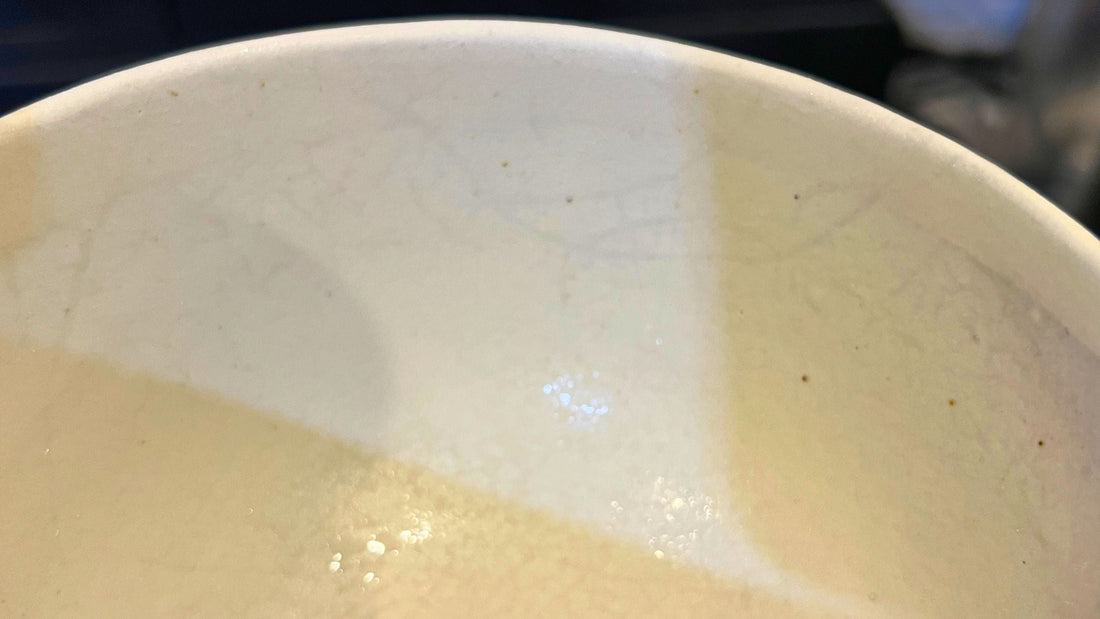
The Art of Japanese Pottery: Embracing Imperfection
Share
What Is Kannyu (Crazing)?


Unlike mass-produced dishware, artisan pottery is individually crafted by a potter who kneads the clay and forms each piece by hand. This process means that elements like small stones, air pockets, or variations in the clay's texture can become part of the piece’s unique character.
After a piece of pottery is fired and cooled, you might notice a delicate, web-like pattern of lines on its surface. This is a phenomenon called kannyu (pronounced "kahn-nyoo"). It occurs when the clay body and the glaze contract at different rates as they cool, causing tiny cracks to form in the glaze. This is especially common in pieces made with coarser clay or a thin glaze. Many potters intentionally use this type of clay to give their work a unique, rustic feel.
It’s important to know that kannyu is not a defect or a sign of damage. In fact, some potters deliberately create crazing as part of the design, celebrating it as a sign of the piece’s authentic, handmade nature.
Kannyu vs. Cracks: How to Tell the Difference
A good way to check for a true crack is to gently run your fingertip over the surface.
- If you feel a catch or a bump, it's likely a true crack that runs deep into the piece.
- Kannyu is within the glaze itself and should feel completely smooth to the touch.
Note: If you are concerned that an item you purchased from us has a true crack, please contact us. We carefully inspect each item before shipping, but damage can sometimes occur during transit. We would be grateful if you could send us a photo via email.
Understanding the Difference: Pottery vs. Porcelain
Kannyu is a characteristic of pottery, and you won't find it on porcelain. Here are the key differences between the two:
- Raw Materials: Pottery is primarily made from earthen clay, while porcelain is made from pottery stone (a white stone containing feldspar and quartz).
- Appearance & Texture: Pottery has a thicker, warmer, and more rustic look with a slightly rough surface. Porcelain is thin, hard, and has a smooth, translucent quality.
- Absorbency: Pottery is porous and absorbs water easily. Porcelain is dense and non-absorbent.
- Sound: When you gently tap a piece of pottery, it makes a dull, low-pitched "clunk" sound. Porcelain makes a clear, high-pitched "ping."
How to Care for Your Pottery
Proper care will ensure your pottery lasts for generations.
Before First Use
We recommend a simple, traditional Japanese method before using a new piece. Warm up rice water (the cloudy water left after rinsing rice) and soak your pottery in it for a while. The starches in the rice water will fill the fine lines of the crazing, making the piece more resistant to absorbing colors from coffee or other foods in the future.
After Use
-
- Wash your pottery with a neutral kitchen detergent. If you use a dishwasher, be careful with high temperatures and make sure pieces don’t knock against each other, as this can cause chips or cracks.
- Always ensure your pottery is completely dry before storing it. Pieces with thin or unglazed sections can hold moisture and may develop mold if not dried properly.
Stains Can Be Beautiful
Over time, your pottery's kannyu may absorb colors from coffee or tea, creating unique, stained patterns. These marks are a sign of a well-loved piece and are often seen as a collaboration between the artist and the user. The more you use it, the more the texture and color will change, giving the pottery a gentle, soft character. Tea ceremony masters, in particular, cherish this transformation, viewing it as "nurturing the vessel."
If you do want to lighten these stains, you can try soaking the piece in a dish-safe bleach, making sure to carefully follow the product's instructions.


If Your Pottery Breaks
If your treasured piece ever breaks, don’t despair! You can bring it back to life with kintsugi, the traditional Japanese art of repairing pottery with lacquer and gold powder. Kintsugi repair kits are available online. Just be sure to use food-safe materials if you plan to use it for dining.
Even if you don't repair it with kintsugi, a broken cup or bowl can be repurposed as a small planter or a decorative item. An artisan's work will be a beautiful addition to any space. So, embrace the joy of using your pottery, and don't be afraid to use it in your daily life.

